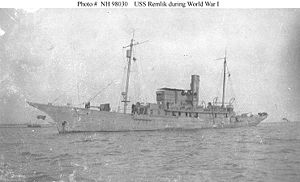USS Remlik (SP-157)
 USS Remlik during World War I. | |
| Career (United States) | 100x35px |
|---|---|
| Name: | USS Remlik |
| Namesake: | Previous name retained |
| Builder: | Cook, Walton, and Gimmell, Hull, England |
| Completed: | 1903 |
| Acquired: |
Purchased 1 June 1917 Delivered to Navy 10 June 1917 |
| Commissioned: | 11 July 1917 |
| Decommissioned: | 7 November 1919 |
| Fate: | Sold 7 June 1920 |
| Notes: | Operated as private yacht SS Candace and SS Remlik 1903-1917 |
| General characteristics | |
| Type: | Patrol vessel |
| Tonnage: | 432 gross tons |
| Displacement: | 600 tons |
| Length: | 200 ft (61 m) |
| Beam: | 23 ft (7.0 m) |
| Draft: | 13 ft 6 in (4.11 m) |
| Propulsion: | Steam engine |
| Speed: | 14 knots |
| Complement: | 62 |
| Armament: |
1 x 3-inch (76.2-millimeter) guns 2 x machine guns |
USS Remlik (SP-157) (sometimes spelled Remlick) was a yacht acquired by the U.S. Navy during World War I. She was converted into an armed patrol craft and assigned to protect ships from German submarines in the North Atlantic Ocean. Post-war she was decommissioned, stripped of naval ordnance and sold in Norfolk, Virginia.
Contents
Construction, acquisition, and commissioning
Remlik was built as the steam-powered civilian yacht SS Candace in 1903 by Cook, Walton, and Gimmell at Hull, England. She later was renamed SS Remlik. The U.S. Navy purchased Remlik from her owner, Willis S. Kilmer of Binghamton, New York, on 1 June 1917 for use as a patrol vessel during World War I. She was delivered to the Navy on 10 June 1917 and, after conversion into a patrol vessel, was commissioned on 11 July 1917 as USS Remlik (SP-157) with Lieutenant Commander I. C. Johnson in command.
Following commissioning, Remlik got underway for France, where, in the late summer of 1917, she assumed antisubmarine patrol and coastal escort duties in the Bay of Biscay. Originally with the 2nd Patrol Division, she later was transferred to the 8th Patrol Division.
Remlik was on patrol duty, fighting a storm, on the morning of 17 December 1917 when she sighted a German submarine off her starboard beam. The submarine submerged before Remlik's gun crews could fire. The submarine's periscope reappeared three times, but the extremely rough weather prevented the submarine from firing her torpedoes and she finally disappeared.
Remlik, although prohibited from using her depth charges by her speed - only 2 knots against the gale - remained in the area in the hope that the submarine would reappear. Shortly after the submarine was last seen, however, the depth charge box on Remlick's taffrail aft was washed overboard. Its depth charge, however, fell inboard, lost its safety pin - arming it - and began rolling around on deck. In the ensuing minutes, Chief Boatswain's Mate John MacKenzie (1886-1933) ran down the deck and, despite the rolling and pitching of the vessel, got a firm grip on the armed depth charge, put it on end, then sat on it to hold it in place until others could lash it down. Mackenzie was awarded the Medal of Honor for his actions.
Remlik continued her patrols and escorted ships along the French coast through the remainder of World War I.
Decommissioning and disposal
After the end of hostilities, Remlik returned to the United States for inactivation. She was decommissioned at Norfolk, Virginia, on 7 November 1919 and was sold to J. S. Webster of Baltimore, Maryland, on 7 June 1920.
References
- This article includes text from the public domain Dictionary of American Naval Fighting Ships. The entry can be found here.
- Department of the Navy Naval Historical Center Online Library of Selected Images: U.S. Navy Ships: USS Remlik (SP-157), 1917-1920. Formerly the Steam Yacht Candace and Remlik
- NavSource Online: Section Patrol Craft Photo Archive: Remlik (SP 157)
